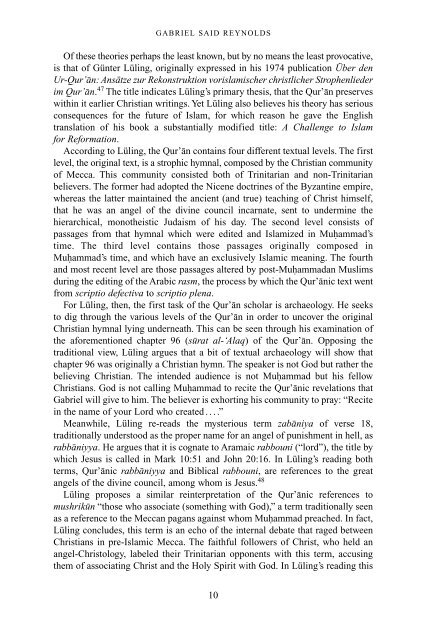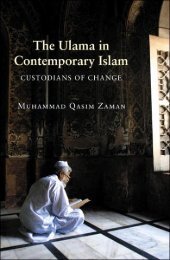The Qur'an in its historical context (pdf - Islam and Christian-Muslim ...
The Qur'an in its historical context (pdf - Islam and Christian-Muslim ...
The Qur'an in its historical context (pdf - Islam and Christian-Muslim ...
You also want an ePaper? Increase the reach of your titles
YUMPU automatically turns print PDFs into web optimized ePapers that Google loves.
GABRIEL SAID REYNOLDS<br />
Of these theories perhaps the least known, but by no means the least provocative,<br />
is that of Günter Lül<strong>in</strong>g, orig<strong>in</strong>ally expressed <strong>in</strong> his 1974 publication Über den<br />
Ur-Qur’an: Ansätze zur Rekonstruktion vorislamischer christlicher Strophenlieder<br />
im Qur’an. 47 <strong>The</strong> title <strong>in</strong>dicates Lül<strong>in</strong>g’s primary thesis, that the Qur’an preserves<br />
with<strong>in</strong> it earlier <strong>Christian</strong> writ<strong>in</strong>gs. Yet Lül<strong>in</strong>g also believes his theory has serious<br />
consequences for the future of <strong>Islam</strong>, for which reason he gave the English<br />
translation of his book a substantially modified title: A Challenge to <strong>Islam</strong><br />
for Reformation.<br />
Accord<strong>in</strong>g to Lül<strong>in</strong>g, the Qur’an conta<strong>in</strong>s four different textual levels. <strong>The</strong> first<br />
level, the orig<strong>in</strong>al text, is a strophic hymnal, composed by the <strong>Christian</strong> community<br />
of Mecca. This community consisted both of Tr<strong>in</strong>itarian <strong>and</strong> non-Tr<strong>in</strong>itarian<br />
believers. <strong>The</strong> former had adopted the Nicene doctr<strong>in</strong>es of the Byzant<strong>in</strong>e empire,<br />
whereas the latter ma<strong>in</strong>ta<strong>in</strong>ed the ancient (<strong>and</strong> true) teach<strong>in</strong>g of Christ himself,<br />
that he was an angel of the div<strong>in</strong>e council <strong>in</strong>carnate, sent to underm<strong>in</strong>e the<br />
hierarchical, monotheistic Judaism of his day. <strong>The</strong> second level consists of<br />
passages from that hymnal which were edited <strong>and</strong> <strong>Islam</strong>ized <strong>in</strong> Muhammad’s<br />
time. <strong>The</strong> third level conta<strong>in</strong>s those passages orig<strong>in</strong>ally composed <strong>in</strong><br />
Muhammad’s time, <strong>and</strong> which have an exclusively <strong>Islam</strong>ic mean<strong>in</strong>g. <strong>The</strong> fourth<br />
<strong>and</strong> most recent level are those passages altered by post-Muhammadan <strong>Muslim</strong>s<br />
dur<strong>in</strong>g the edit<strong>in</strong>g of the Arabic rasm, the process by which the Qur’anic text went<br />
from scriptio defectiva to scriptio plena.<br />
For Lül<strong>in</strong>g, then, the first task of the Qur’an scholar is archaeology. He seeks<br />
to dig through the various levels of the Qur’an <strong>in</strong> order to uncover the orig<strong>in</strong>al<br />
<strong>Christian</strong> hymnal ly<strong>in</strong>g underneath. This can be seen through his exam<strong>in</strong>ation of<br />
the aforementioned chapter 96 (surat al-‘Alaq) of the Qur’an. Oppos<strong>in</strong>g the<br />
traditional view, Lül<strong>in</strong>g argues that a bit of textual archaeology will show that<br />
chapter 96 was orig<strong>in</strong>ally a <strong>Christian</strong> hymn. <strong>The</strong> speaker is not God but rather the<br />
believ<strong>in</strong>g <strong>Christian</strong>. <strong>The</strong> <strong>in</strong>tended audience is not Muhammad but his fellow<br />
<strong>Christian</strong>s. God is not call<strong>in</strong>g Muhammad to recite the Qur’anic revelations that<br />
Gabriel will give to him. <strong>The</strong> believer is exhort<strong>in</strong>g his community to pray: “Recite<br />
<strong>in</strong> the name of your Lord who created....”<br />
Meanwhile, Lül<strong>in</strong>g re-reads the mysterious term zabaniya of verse 18,<br />
traditionally understood as the proper name for an angel of punishment <strong>in</strong> hell, as<br />
rabbaniyya. He argues that it is cognate to Aramaic rabbouni (“lord”), the title by<br />
which Jesus is called <strong>in</strong> Mark 10:51 <strong>and</strong> John 20:16. In Lül<strong>in</strong>g’s read<strong>in</strong>g both<br />
terms, Qur’anic rabbaniyya <strong>and</strong> Biblical rabbouni, are references to the great<br />
angels of the div<strong>in</strong>e council, among whom is Jesus. 48<br />
Lül<strong>in</strong>g proposes a similar re<strong>in</strong>terpretation of the Qur’anic references to<br />
mushrikun “those who associate (someth<strong>in</strong>g with God),” a term traditionally seen<br />
as a reference to the Meccan pagans aga<strong>in</strong>st whom Muhammad preached. In fact,<br />
Lül<strong>in</strong>g concludes, this term is an echo of the <strong>in</strong>ternal debate that raged between<br />
<strong>Christian</strong>s <strong>in</strong> pre-<strong>Islam</strong>ic Mecca. <strong>The</strong> faithful followers of Christ, who held an<br />
angel-Christology, labeled their Tr<strong>in</strong>itarian opponents with this term, accus<strong>in</strong>g<br />
them of associat<strong>in</strong>g Christ <strong>and</strong> the Holy Spirit with God. In Lül<strong>in</strong>g’s read<strong>in</strong>g this<br />
10



